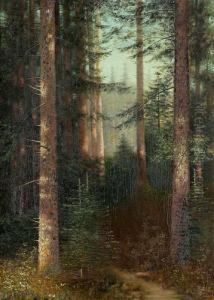Michael Rudisuhli Paintings
Michael Rudisuhli was a Swiss artist born in 1881, whose artistic journey spanned the late 19th and early 20th centuries, a period rich in stylistic transformations and innovations in the world of art. Rudisuhli's oeuvre, primarily known for its vivid landscapes and intimate interior scenes, reflects a deep engagement with the natural world and an acute sensitivity to the nuances of light and color. His work, while not as widely recognized as some of his contemporaries, offers a unique perspective on the transition from traditional to modernist approaches in art.
Rudisuhli's early years were spent in Switzerland, where he was deeply influenced by the country's picturesque landscapes and the changing seasons. These elements became recurrent themes in his work, capturing the ephemeral beauty of nature with a keen eye for detail and a bold use of color. He was educated in various European art schools, where he was exposed to a range of artistic movements, from Impressionism to Post-Impressionism, which played a significant role in shaping his stylistic development.
Throughout his career, Rudisuhli exhibited a remarkable ability to evolve his technique and style. His early works were characterized by a more traditional, realist approach, focusing on the accurate depiction of natural and architectural forms. However, as his career progressed, he began to experiment with looser brushwork and more vibrant color palettes, indicating the influence of Impressionism and the burgeoning modernist movement. Despite these stylistic shifts, his work remained deeply personal and introspective, often exploring the interplay between light and shadow and the subtle moods of different environments.
Rudisuhli's contributions to art were not limited to his paintings. He was also an active participant in the artistic community, engaging with other artists and contributing to the dialogue around the evolution of modern art. His works were exhibited in various galleries across Europe, gaining him recognition and respect among his peers. Despite this, he remained somewhat on the periphery of the major artistic movements of his time, which has contributed to the relative obscurity of his work in the broader historical narrative of art.
Michael Rudisuhli passed away in 1932, leaving behind a body of work that, though not as widely celebrated as some of his contemporaries, offers a compelling glimpse into the transitionary period of early 20th-century art. His paintings, with their rich colors and emotive landscapes, continue to be appreciated by art lovers and collectors who are drawn to his unique vision and the quiet beauty of his work.
